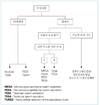Abstract
As a result of the technological advance provided by intracytoplasmic sperm injection (ICSI) in 1992, the evaluation and treatment of the infertile male has changed significantly. Many men who were previously thought to be irreversibly infertile have the potential to initiate their own biologic pregnancy. However, not all men having impaired semen parameter are ideal candidates for ICSI for numerous reasons including a lack of addressing the underlying problem causing the male infertility, unknown genetic consequences, and cost-effectiveness issues. In this era of ICSI, the fundamental approach to the male with suspected subfertility is unchanged and is based on a history, physical examination, and focused laboratory testing. The urologist should approach the patient with an intent to identify remediable causes of subfertility given the specific clinical situation. For instance, should a gentleman have his varicocele repaired or vasectomy reversed, or should he proceed directly with ICSI? If no factors can be improved in a timely manner, then ICSI should be considered using the available sperm. Examples of recent advances include the diagnosis and treatment of ejaculatory duct obstruction, indications and techniques for performing test is biopsy, and technique for sperm harvesting. In addition, potential genetic causes of male subfertility should be diagnosed and discussed with the patient. Cystic fibrosis gene mutation, karyotype abnormalities, and Y-chromosome microdeletions all have recently been identified as causative for male infertility in otherwise phenotypically normal men. With recently evolved diagnostic and therapeutic techniques now available for the infertile couple, even the most severe male factor problems in patients previously considered irreversibly infertile are now potentially treatable. The physician should be aware of the availability and limitations of these new and exciting reproductive technologies because they will allow him to provide timely and more effective therapy for the infertile couple. An understanding of these advances by all physicians is important as we progress into the 21st century.
References
1. Palermo G, Joris H, Devroey P, Van Steirterhem AC. Pregnancies after intracytoplasmic injection of single spermatozoon into an oocyte. Lancet. 1992. 340:17–18.

3. MacLeod J. Semen quality in one thousand men of known fertility and eight hundred cases of infertile marriages. Fertil Steril. 1951. 2:115.

4. Sigman M, Jarow JP. Walsh PC, retik Ab, Vanghan ED, Wein AJ, editors. Male infertility. Campbell's Urology. 2002. 8th ed. Philadelphia: WB Saunders;1475–1476.
5. Lee PA. Fertility in cryptorchidism : does treatment make a difference? Endocrinol Metab Clin North Am. 1993. 22:479–490.
6. Beard CM, Benson RC Jr, Kelalis PP, Elveback LR. The incidence and outcome of mumps orchitis in Rochester, Minnesota, 1935 - 1974. Mayo Clin Proc. 1977. 52:3–7.
7. Kim ED, Lipshultz LI. Evaluation and imaging of the infertile male. Infert Reprod Med Clin North Am. 1999. 10:377–409.
8. Kim ED, Moty A, Seo JT. Male contraception and contraception. The Clinics Atlas of Office Procedures Office Urology. 2002. 5:77–79.
9. Thomas AJ Jr, Howards SS. Lipshultz LI, Howards SS, editors. Microsurgical treatment of male infertility. Infertility in the male. 1997. 3rd ed. St Louis: Mosby;371–384.
10. Belker AM, Thomas AJ, Fuchs EF, Konnak JW, Sharlip ID. Result of 1,469 microsugical vasectomy reversal by the vasostomy study group. J Urol. 1991. 145:505–511.

11. Niederberger C, Ross LS. Microsugical epididymovasostomy : predictors of success. J Urol. 1993. 149:1364–1367.
12. Goldstein M, Gilbert BR, Dicker AP, Dwosh J, Gnecco C. Microsurgical inguinal varicocelectomy with delivery of the testis : an artery and lymphatic sparing technique. J Urol. 1992. 148:1808–1811.

13. Meacham RB, Hellerstein DK, Lipshultz . Evaluation and treatment of ejaculatory duct obstruction in the infertile male. Fertil Steril. 1993. 59:393–397.

19. Foresta C, Moro E, Ferli A. Y chromosome microdeletions and alteration of spermatogenesis. Endocr Rev. 2001. 22:226–239.




 PDF
PDF ePub
ePub Citation
Citation Print
Print








 XML Download
XML Download